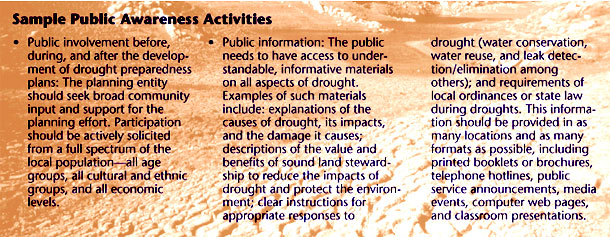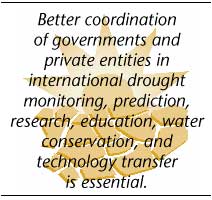|
|
| Return to Table of Contents |
 |
|
GOAL 2 |
Improve collaboration among scientists and managers to enhance the effectiveness of observation networks, monitoring, prediction, information delivery, and applied research and to foster public understanding of and preparedness for drought. Our findings and
conclusions point out the value of observation networks, monitoring,
prediction, information gateways and delivery, and research to drought
preparedness. The National Drought Council (see Recommendation 5.1) will
coordinate a formal process—such as a drought data monitoring,
prediction, and research "summit" of multi-disciplinary,
geographically diverse representatives—to ascertain the needs and
expectations of all interested parties as a first step toward
prioritizing recommendations. Research priorities should address the
impacts of drought on non-irrigated systems, aquatic ecosystems,
wildlife, and other aspects of the natural environment, including the
potential negative impacts of drought mitigation measures. Better
coordination of governments and private entities in international
drought monitoring, prediction, research, education, water conservation,
and technology transfer is essential. The National Drought Council’s
annual reports will include a description of the information products
most needed to reduce drought impacts (see Recommendation 5.4). |
|
|
Specific Recommendations 2.1 The
President should appropriately direct and Congress, as necessary, should
authorize and fund a viable plan to maintain, modernize, expand, and
coordinate a system of observation networks that meets the needs of the
public at large. The plan should include cooperation with states,
development and improvement of baseline historical data sets, and
recognition of the recommendations made by the National Drought Council.
Priority should be placed on filling the gaps on tribal lands and in
rural America. Examples of critical observation networks are in the box
on the |
|
|

